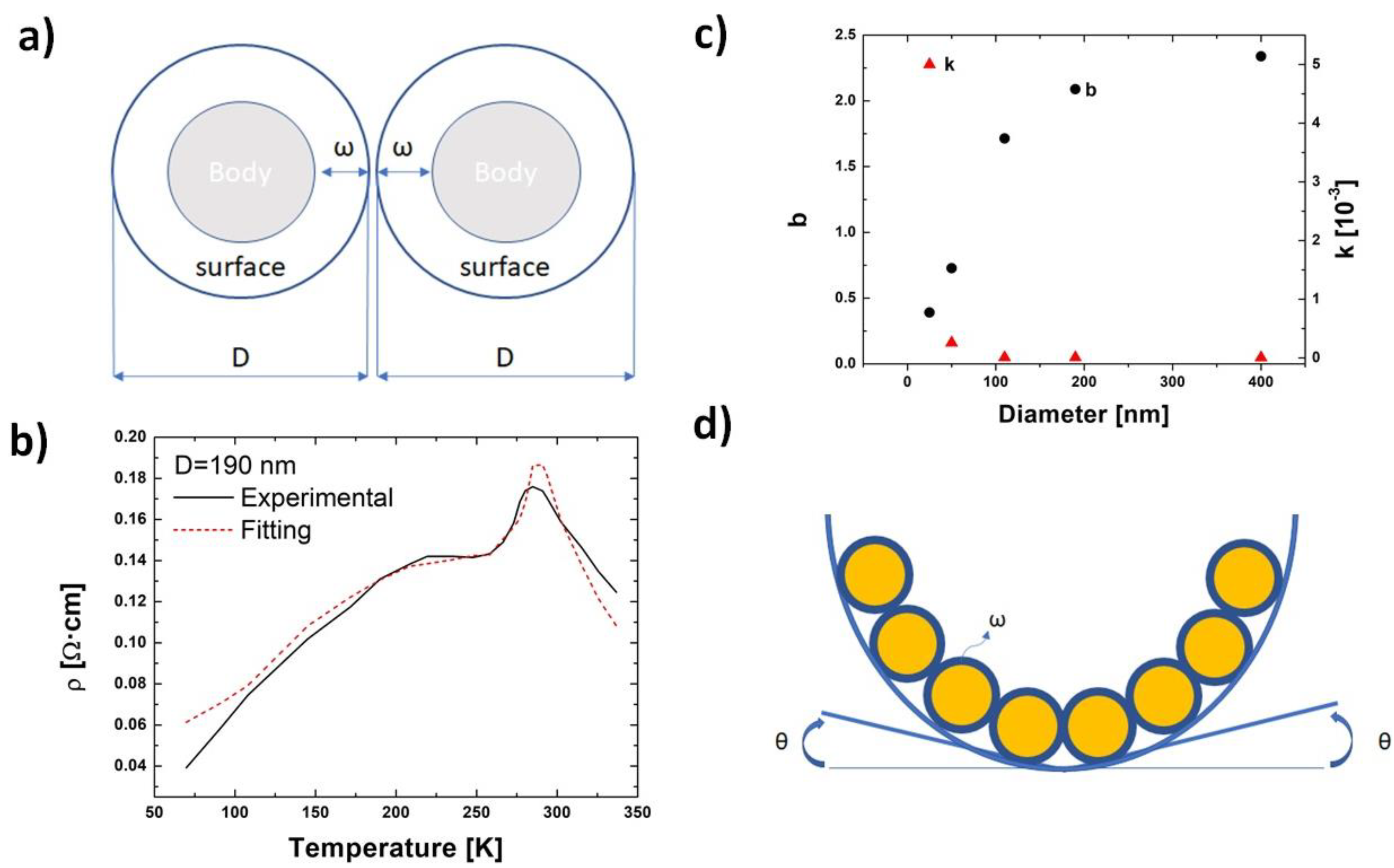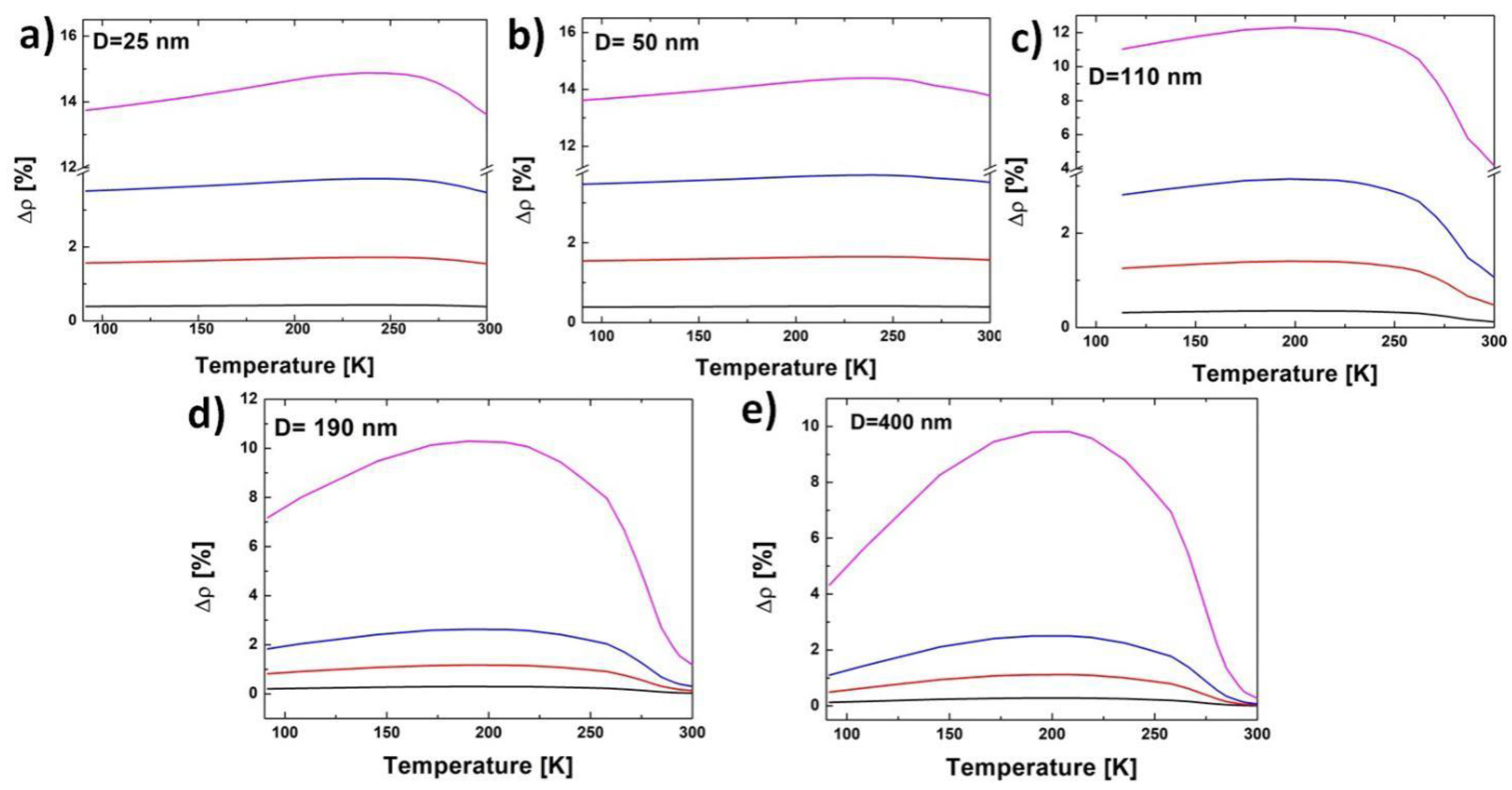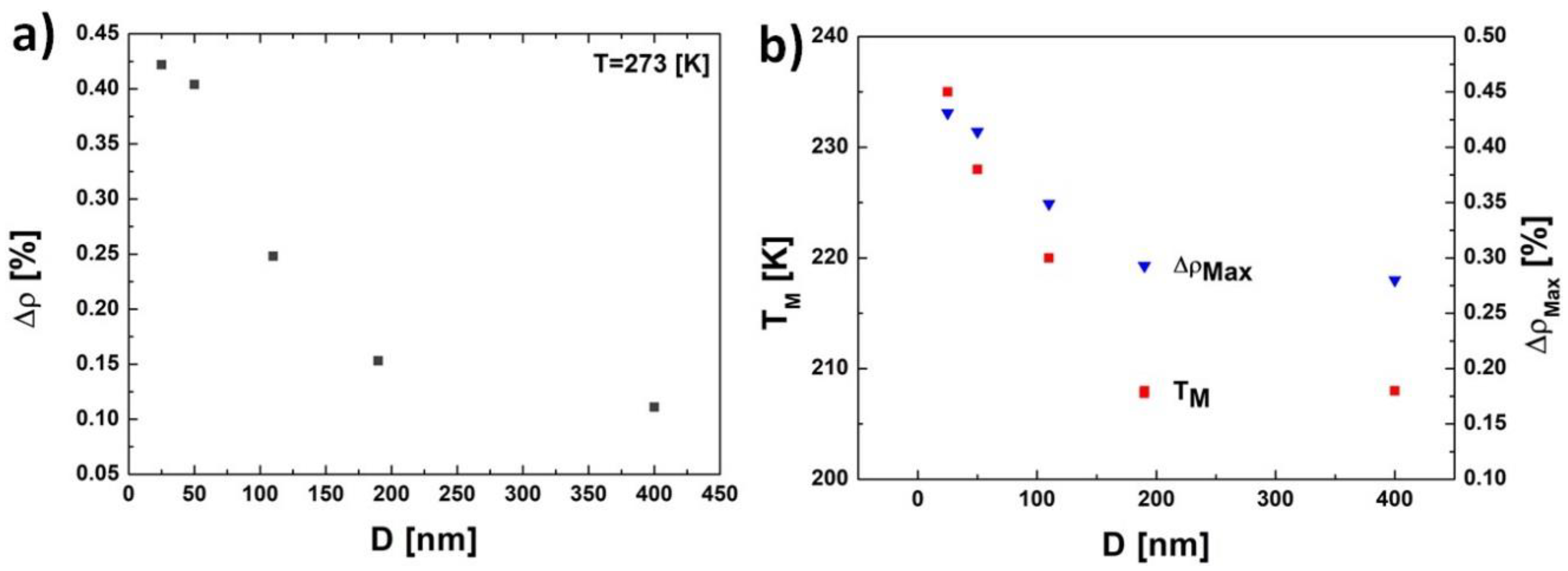Strain-Dependent Resistivity of Granular Manganite Systems: A Simple Quantitative Approach
Abstract
1. Introduction
2. Results and Discussion
3. Conclusions
Author Contributions
Funding
Conflicts of Interest
References
- Bhalla, A.; Guo, R.; Roy, R. The perovskite structure: A review of its role in ceramic science and technology. Mater. Res. Innov. 2000, 4, 3–26. [Google Scholar] [CrossRef]
- Hu, Y.; Guo, Y.; Wang, Y.; Chen, Z.; Sun, X.; Feng, J.; Ming Lu, T.; Wertz, E.; Shi, J. A review on low dimensional metal halides: Vapor phase epitaxy and physical properties. J. Mater. Res. 2017, 32, 3992–4024. [Google Scholar] [CrossRef]
- Viret, M.; Ranno, L.; Coey, J.M.D. Magnetic localization in mixed-valence manganites. Phys. Rev. B 1997, 55, 8067–8070. [Google Scholar] [CrossRef]
- Guiton, B.S.; Davies, P.K. Nano-chessboard superlattices formed by spontaneous phase separation in oxides. Nat. Mater. 2007, 6, 586–591. [Google Scholar] [CrossRef]
- Erni, R.; Abakumov, A.M.; Rossell, M.D.; Batuk, D. Nanoscale phase separation in perovskite revisited. Nat. Mater. 2014, 13, 216–217. [Google Scholar] [CrossRef]
- Tennyson, E.M.; Doherty, T.A.S.; Stranks, S.D. Heterogeneity at multiple lenght scales in halide perovskite smiconductors. Nat. Rev. Mater. 2019, 4, 573–587. [Google Scholar] [CrossRef]
- Dogan, F.; Lin, H.; Guilloux-Viry, M.; Pena, O. Focus on properties and applications of perovskites. Sci. Technol. Adv. Mater. 2015, 16, 020301. [Google Scholar] [CrossRef]
- Salamon, M.B.; Jaime, M. The physics of manganites: Structure and transport. Rev. Mod. Phys. 2001, 73, 583. [Google Scholar] [CrossRef]
- Haghiri-Gosnet, A.M.; Renard, J.P. CMR manganites: Physics, thin films and devices. J. Phys. D Appl. Phys. 2003, 36, R127. [Google Scholar] [CrossRef]
- Salafranca, J.; Calderón, M.J.; Brey, L. Magnetoresistance of an all-manganite spin valve: A thin antiferromagnetic insulator sandwiched between two ferromagnetic metallic electrodes. Phys. Rev. B 2008, 77, 14441–14445. [Google Scholar] [CrossRef]
- Prasad, B.; Blamire, M. Fully magnetic manganite spin filter tunnel junctions. Appl. Phys. Lett. 2016, 109, 132407–132411. [Google Scholar] [CrossRef]
- Millis, J.; Darling, T.; Migliori, A. Quantifying strain dependence in “colossal” magnetoresistance manganites. J. Appl. Phys. 1998, 83, 1588–1591. [Google Scholar] [CrossRef]
- Adamo, C.; Ke, X.; Wang, H.Q.; Xin, H.L.; Heeg, T.; Hawley, M.E.; Zander, W.; Schubert, J.; Schiffer, P.; Muller, D.A.; et al. Effect of biaxial strain on the electrical and magnetic properties of (001) La0.7Sr0.3MnO3 thin films. Appl. Phys. Lett. 2009, 95, 112504–112506. [Google Scholar] [CrossRef]
- Ovsyannikov, G.A.; Shaikhulov, T.A.; Shakhunov, V.A.; Preobrazhensky, V.L.; Mathurin, T.; Tiercelin, N.; Pernod, P. Resistivity of manganite thin film under strain. J. Supercond. Novel Magn. 2019, 32, 2759–2763. [Google Scholar] [CrossRef]
- Ahn, K.H.; Lookman, T.; Bishop, A.R. Strain-induced metal-insulator phase coexistence in perovskite manganites. Nature 2004, 428, 401–404. [Google Scholar] [CrossRef]
- Petrov, A.Y.; Aruta, C.; Mercone, S.; Adamo, C.; Alessandri, I.; Maritato, L. Room temperature metal-insulator transition in as grown (La1-xSrx)(y)MnO3 thin films deposited by molecular beam epitaxy. Eur. Phys. J. B 2004, 40, 11–17. [Google Scholar] [CrossRef]
- Chen, Y.H.; Wu, T.B. Thickness dependent transport properties and percolative phase separation in polycrystalline manganite thin films. Appl. Phys. Lett. 2008, 93, 224104. [Google Scholar] [CrossRef]
- Kataria, B.; Solanki, P.; Kachr, U.; Vagadia, M.; Ravalia, A.; Keshvani, M.J.; Trivedi, P.; Venkateshvarlu, D.; Ganesan, V.; Kandasami, A.; et al. Role of strain and microstructure in chemical solution deposited La0.7Pb0.3MnO3 manganite films: Thickness dependent swift heavy ions irradiation studies. Radiat. Phys. Chem. 2013, 85, 173–178. [Google Scholar] [CrossRef]
- Pryds, N.; Esposito, V. When two become one: An insight into 2D conductive oxide interfaces. J. Electroceram. 2017, 38, 1–23. [Google Scholar] [CrossRef]
- Zhang, N.; Ding, W.; Zhong, W.; Xing, D.; Du, Y. Tunnel-type giant magnetoresistance in the granular perovskite La0.85Sr0.15MnO3. Phys. Rev. B 1997, 56, 8138–8142. [Google Scholar] [CrossRef]
- de Andrés, A.; García-Hernández, M.; Martínez, J.L. Conduction channels and magnetoresistance in polycrystalline manganites. Phys. Rev. B 1999, 60, 7328. [Google Scholar] [CrossRef]
- Chen, A.; Bi, Z.; Tsai, C.-F.; Lee, J.H.; Su, Q.; Zhang, X.; Jia, Q.; MacManus-Driscoll, J.L.; Wang, H. Tunable low-field magnetoresistance in (La0. 7Sr0. 3MnO3) 0.5:(ZnO) 0.5 self-assembled vertically aligned nanocomposite thin films. Adv. Funct. Mater. 2011, 21, 2423. [Google Scholar] [CrossRef]
- Cojocaru, S.; Naddeo, A.; Citro, R. Modification of the Bloch law in ferromagnetic nanostructures. Europhys. Lett. 2014, 106, 17001–17006. [Google Scholar] [CrossRef]
- Malvern, L.E. Introduction to the Mechanics of a Continous Medium; Prentice-Hall, Inc.: Englewood Cliffs, NJ, USA, 1969; ISBN 978-0134876030. [Google Scholar]
- Haus, H.A.; Melcher, J.R. Electromagnetic Fields and Energy; Prentice Hall: Englewood Cliffs, NJ, USA, 1988; ISBN 9780132490207. [Google Scholar]



| D [nm] | |
|---|---|
| 25 | 0.42 |
| 50 | 0.40 |
| 110 | 0.25 |
| 190 | 0.15 |
| 400 | 0.11 |
Publisher’s Note: MDPI stays neutral with regard to jurisdictional claims in published maps and institutional affiliations. |
© 2020 by the authors. Licensee MDPI, Basel, Switzerland. This article is an open access article distributed under the terms and conditions of the Creative Commons Attribution (CC BY) license (http://creativecommons.org/licenses/by/4.0/).
Share and Cite
De Feo, P.; Ferraioli, F.; Coppola, N.; Maritato, L. Strain-Dependent Resistivity of Granular Manganite Systems: A Simple Quantitative Approach. Coatings 2020, 10, 1081. https://doi.org/10.3390/coatings10111081
De Feo P, Ferraioli F, Coppola N, Maritato L. Strain-Dependent Resistivity of Granular Manganite Systems: A Simple Quantitative Approach. Coatings. 2020; 10(11):1081. https://doi.org/10.3390/coatings10111081
Chicago/Turabian StyleDe Feo, Pasquale, Fabrizio Ferraioli, Nunzia Coppola, and Luigi Maritato. 2020. "Strain-Dependent Resistivity of Granular Manganite Systems: A Simple Quantitative Approach" Coatings 10, no. 11: 1081. https://doi.org/10.3390/coatings10111081
APA StyleDe Feo, P., Ferraioli, F., Coppola, N., & Maritato, L. (2020). Strain-Dependent Resistivity of Granular Manganite Systems: A Simple Quantitative Approach. Coatings, 10(11), 1081. https://doi.org/10.3390/coatings10111081







